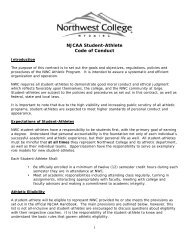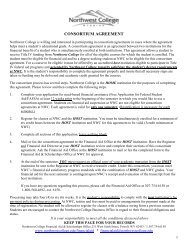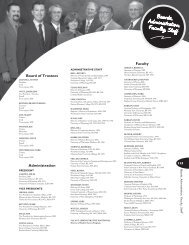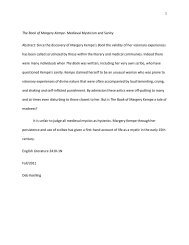Uncle Tom's Cabin
Uncle Tom's Cabin
Uncle Tom's Cabin
You also want an ePaper? Increase the reach of your titles
YUMPU automatically turns print PDFs into web optimized ePapers that Google loves.
8<br />
Stowe also uses a feminized Tom in presenting her values and observations about the<br />
conflicts within the slave-based system. Throughout <strong>Uncle</strong> Tom’s <strong>Cabin</strong>, Stowe focuses on<br />
men’s roles and behaviors in her society and questions the validity of the popular perceptions of<br />
men. During Stowe’s time period, traditional masculinity tended to lean toward tactics of<br />
aggression; as Cynthia Wolff states in her article, “By [the] mid-nineteenth century, a formulaic<br />
image of a ruthless, power-hungry American manhood had developed …. Traits such as selfsacrifice<br />
and sensitivity to the needs of others were anathema to this crude masculine stereotype”<br />
(Wolff 599). To combat this attitude, Stowe used feminine heroes such as Tom. After all, if her<br />
society defined masculinity based on principles of competition and conquest, Stowe decided that<br />
masculinity needed a new definition if slavery were to be combated (Wolff 600). It is thus<br />
interesting that Tom, the main character of the novel, is, as Elizabeth Ammons mentions,<br />
“gentle, pious, chaste, domestic, long-suffering and self-sacrificing” (Ammons 162). Therefore,<br />
Tom is characterized by meekness, servility, faith, devotion to his family, and a protective,<br />
loving nature. Furthermore, he is entirely nonviolent; there is not a single instance in the novel in<br />
which he engages in violent behavior to protect himself. Even when protecting others, as in his<br />
final confrontation with Legree, Tom simply refuses to tell Legree where Cassy and Emmeline<br />
are and meekly bears Legree’s fury, even accepting death for the protection of others (Stowe<br />
376). In stark contrast to Tom’s feminine virtue, those who demonstrate traditional masculinity<br />
actually become villains. Among these, Legree is the most degraded man in the novel, but he is<br />
also the man who is most “masculine,” according to Stowe’s society’s definition. By presenting<br />
Tom the way she does, Stowe manages to create sympathy for the black race and illustrate her<br />
idea of perfect masculinity.











